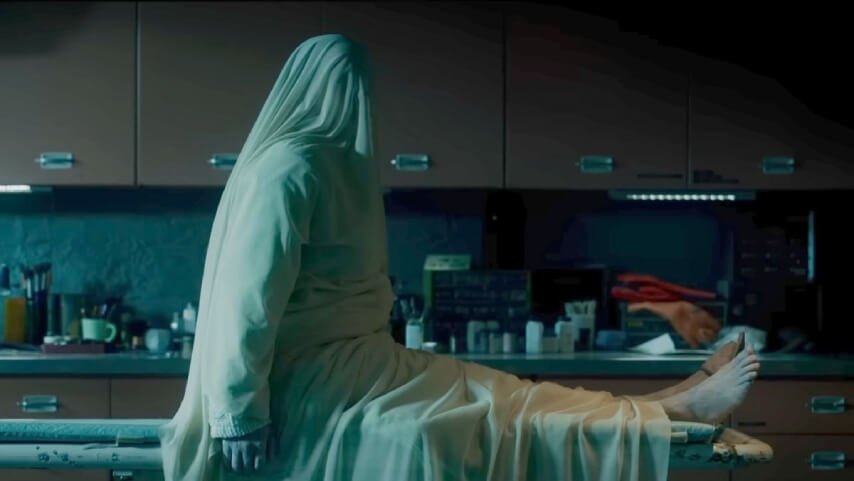Stephen King wasn’t setting out to reinvent the vampire story with Salem’s Lot. His sophomore novel simply immigrated the bloodsuckers to an insular community of gossips so stagnant that it was already flirting with undeath. Remove the townie drama, and you have a simple creature feature—thin as Max Schreck’s Count Orlok—where a small group of survivors plays Whac-A-Mole with those already turned into creatures of the night. This is the fate befalling the straight-to-streaming film adaptation, stripped to the bones by writer-director Gary Dauberman. Salem’s Lot rises after years in the dark, a vampire tale with no heart and no stakes.
A longtime player in The Conjuring universe, who also helped write the It films, Dauberman this time finds himself not with two movies to adapt a King novel, but less than two hours. That’s not a lot of time to sketch out the prickly Maine village of Jerusalem’s Lot, the folks who live there, the folks who’ve just arrived there, and the vampires threatening them all. Author Ben (Lewis Pullman), stoic to the point of smugness, barely has a chance to catch his breath after crossing the city limits back into his childhood hometown before he’s beset by plot from all sides.
Some of this takes the form of flirty local Susan (Makenzie Leigh, charming), some the form of meaningfully long looks at the spooky mansion on the hill or the suspicious fop manning the antique store. Most prominent though, are the missing kids, snatched up by that European fancypants Straker (Pilou Asbæk) as an offering to his dark master, Barlow.
But the skyrocketing mortality rate and streak of anemia running through the not-so-red-blooded population of Salem’s Lot never drums up the xenophobic ire of its residents, nor does it even strike “stranger danger” fear into the hearts of its parents. As the death count mounts through sequences more stylish than scary—Dauberman’s film, not bad-looking on the whole, shifts between the blanketed tones of sepia, blue-green, and taillight red coating many of Atomic Monster’s horror films—Salem’s Lot fails to build a cohesive, mounting atmosphere of dread.
That’s because the characters persisting under these increasingly deadly conditions are so disconnected that only the magnetic pull of the plot yanks them together. Ben and Susan fall backwards into the vampire-hunting business mid-fling thanks to kindhearted elementary school teacher Matt (Bill Camp), who happens to be a vampire expert. Why Matt contacts the ineffectual pair to help is unclear—he’s only met the author once and seems to know everyone in town—but at least it makes sense to want a doctor (Alfre Woodard) and a priest (John Benjamin Hickey) on your side in this situation. Best to hedge your bets. Tagging along is ridiculously tough super-kid Mark (Jordan Preston Carter), who is more Terminator than ten-year-old.
This Scooby-Doo party exchanges little banter, the best lines going to Woodard’s fed-up skeptic, as they march through town, splitting up at various moments so as to best be picked off. As the vampirism epidemic ravages Salem’s Lot, it mainly manifests as a kid with glowing eyes, a dead mom draped in a mortuary sheet, and a lot of cheap-looking FX that would feel more at home in a SYFY Original. (Though Max Originals have quickly earned a similar pedigree.)
Most disappointing is Barlow himself. The head vampire is clumsily hidden for much of the film, only leaping out or extending a clawed arm for a few jump scares, but he’s not a shocking enough creation to be deployed like one of James Wan’s demons. His design errs towards Tobe Hooper’s much better ‘70s miniseries adaptation, but that monster’s vicious makeup and theatrical, bat-like silhouette have been smoothed over and flattened like a modernist corporate logo.
This soulless slickness carries over to some of Dauberman’s stylized transitional flourishes, as scenes blend into one another, briskly heading towards the next monstrous run-in. Rather than keeping the blood pumping, this pacing rushes past any characterization or mistrustful thematic undercurrents or consistencies in mythology—all the things that put color in the cheeks of movies like this. Half the time, horror sequences are derailed by the questions they raise. Early on, vampires need an invitation into homes; later they waltz right in. The compelling thrall of a vampire’s gaze works until it doesn’t, as do the pulpy glowing crosses wielded against them.
Salem’s Lot isn’t a disaster (far worse horror films have made plenty of money at the box office), but a bloodless and frail version of the story drained of its vitality. The human details that make King’s novel compelling beyond its campfire-story premise are reduced to shorthand or discarded entirely; all the folksy drama, fear of outsiders, and period signifiers are boiled away. From the streaming-centric opening credits—with rivulets of blood trickling across expository documents and a map of Maine, evoking Game Of Thrones, Shogun, and Rings Of Power—Salem’s Lot feels optimized, streamlined, and totally defanged.
Director: Gary Dauberman
Writer: Gary Dauberman
Starring: Lewis Pullman, Alfre Woodard, Makenzie Leigh, Bill Camp, Spencer Treat Clark, Pilou Asbæk, John Benjamin Hickey
Release Date: October 3, 2024 (Max)

